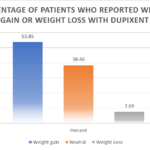Why Does Dupixent Hurt So Much? Because you are allergic to the medicine, terrified of needles, or injecting it in the wrong spot, or for so many other reasons.
Most people do not feel it or have just a sting or a pinch of pressure. Some people do not feel the needle entering the skin but feel severe pain when the medicine is pushed.
A good injection technique, desensitization, injecting the medicine into the proper spot, and keeping your nerves calm before the injection may help you a lot.
Dupixent Injection:
Dupixent injection is administered into the skin of the tummy, thighs, and upper arm. It is indicated in the treatment of the following conditions:
- Moderate to severe allergic asthma
- Atopic dermatitis (Eczema)
- Chronic rhinosinusitis with nasal polyps
- Eosinophilic esophagitis
The frequency of Dupixent injection and the dose depend on the underlying condition. You may be asked to inject it weekly, every two weeks, or even monthly.
You can see your Dupixent dosage frequency here: Dupixent Injection Dosage Frequency
How is Dupixent injection administered?
Dupixent injection (Dupilumab) is administered subcutaneously into the skin. It is administered just like insulin.
The preferred areas of injection are:
- The tummy (3 – 5 cm away from the navel)
- Thighs, and
- The Upper arms
It is not recommended to inject Dupixent into the skin of the upper arms yourself. The best site is the tummy, and that is the area where people may feel the least pain.

Although subcutaneous injections are relatively painless compared to intramuscular or intravenous injections, they may hurt as well.
Why Does Dupixent Hurt So Much?
Some people may feel extra pain when injecting Dupixent. A few of the reasons people feel so much pain are:
A wrong injection technique:
If wrongly administered, Dupixent injection may hurt a lot. Some of the wrong injection techniques are listed here:
- Injecting Dupixent at the wrong angle
- Injecting it into the wrong spot
- Injecting Dupixent into a hard and indurated skin area
- Injecting it into inflamed, infected, or bruised skin
- Injecting Dupixent into areas where another drug has recently been injected, such as insulin.
- Injecting it into hypersensitive skin, such as skin with healed lesions of shingles.
- Injecting Dupixent into hairy areas of the skin
Wrong injection preparation:
Sometimes, poor preparation before injecting Dupixent can also hurt. Poor preparation means:
- Inject it while it is still chilly or immediately after taking it out of the refrigerator.
- Injecting the same needle twice or repeatedly because you failed to fully inject the drug at once
- Injecting the drug too fast
Injecting at the wrong spot:
This is one of the common reasons why the injection may hurt. Some people may feel more pain when Dupixent is injected into the skin of the thighs, while others may feel more pain at other sites. It is generally better tolerated when injected into the skin of the stomach.
However, being too close to the navel might hurt as well. Injection into the skin of the forearm or calf muscles (legs) is not recommended.
Even self-injection into the arms is not recommended.
Sometimes, when injected by an experienced nurse or a healthcare provider, it may hurt too little.
Summary of Why Does Dupixent Hurt So Much?
| 1. Wrong Injection Technique | 2. Wrong Injection Preparation | 3. Wrong Injection Spot |
How to Make Dupixent Hurt Less?
To make the injection hurt the least, the first thing is to inject it properly and into the right spot. Also, you need to overcome your fears. For most people, the prick is just like a light pinch or a sting.
Where should you inject to feel the least pain?
As mentioned above, the three recommended areas of injection are:
- the stomach (3 to 5 cm away from the navel)
- the thighs, and
- the upper arms
Self-injection into the upper arms is not recommended. The upper arms have the least fat and the skin is thin, so out of the three recommended areas, this area hurts the most.
Most people feel the least pain when they inject it into the skin of the tummy where most fats are. However, some people feel the least pain when they inject it into the mid-thighs.
Too far away from the navel, as in the extreme right or left sides of the tummy, or too above or below the navel, such as the skin just above the pubic area and below the chest,t should be avoided.
When injecting into the thighs, the front or sides of the mid-thighs are the best areas to inject. Too far below and above the mid-thighs is not recommended and might hurt a lot.
What is the best angle of the needle that hurts less?
Subcutaneous injections are generally injected straight into the skin. The needle is kept at 90 degrees to the skin.
For people who are skinny, have very little fat, or when the drug is administered into the skin of the upper arms, the needle can be kept at 45 degrees.
The skin is pinched to make a fold, and then the needle is inserted straight or at 45 degrees.
Don’t inject it right away!
Don’t be in a hurry. When you take the injection out from the refrigerator, keep it for about 30 minutes or even a little more to bring the temperature of the injection down to room temperature.
Inserting the needle might not hurt, but the chilly injection hurts a lot. If you are in a hurry, keep the injection under your armpit or in your hand for a few minutes.
Inject slowly:
The needle is so small, sharp, and smooth that you won’t feel it going in if it’s done the right way. However, after the needle is in, injecting the medicine might hurt.
It might hurt a lot if you go too fast. Injecting the fluid slowly over a minute will hurt much less compared to fast injections.
Take help:
Sometimes, you may feel more pain if you inject the drug yourself. If you are too scared of injections, get help from a friend or a family member initially. Once you get used to it, try it yourself.
Furthermore, with repeated injections, you may get desensitized, and the injections will hurt very little, or you may not feel it at all.
Try the syringe if you feel pain using the autoinjector and vice versa:
While reviewing patients’ records, some people stated that they felt less pain when they used the syringe because they could control the speed of the injection.
With the autoinjector, one can not control the speed, and that may hurt.
However, for others, the syringe was more painful than the autoinjector.
Some patients who used the autoinjector stated that they experienced less pain when they injected it in the sides or front of the middle of the thighs than in the very upper or lower part of the thighs.
If you are skinny, you may not control the pain …
Some skinny people with low body fat feel more pain when injecting it compared to people who are fat. It is also one of the reasons people feel more pain when they inject it into the arm or even the thighs.
The maximum you can do is to find out where most of the body fat is located. Usually, it’s the abdomen but some people have more fat on the thighs.
Inject Dupixent where most of the fat is located.
Desensitization: Time is the best healer …
Desensitization is a process where a person gets used to medicine with repeated administration. If you are sensitive to the drug itself, your pain threshold might increase with time, and you’ll feel it lesser and lesser with time.
Some patients are less scared of the needle, but they are very sensitive to the medicine.
One patient described it as if she were injecting a burning syrup into the skin. She tried the syringe as well as the autoinjector.
In addition, she tried injecting it into the stomach as well, but once she pushed the medicine, it hurt.
In such a patient, desensitization may help. Starting with a low dose and titrating to the maximum effective dose is one option. Although this is not recommended by the manufacturer.
Identify allergic reactions to Dupixent:
Sometimes, patients develop an allergic reaction to Dupixent. Allergic reactions may manifest as:
- Redness, itching, and swelling around the injection site
- A localized bump after Dupixent injection
- Fever, facial and lip swelling, difficulty breathing, and
- Hypotension in extreme cases
Localized injection-site reactions may manifest as severe pain. If you have other symptoms such as redness, a bump after the Dupixent injection, and itching along with pain, then you are more likely to have developed an allergic reaction to the drug.
Antihistamines such as Benadryl, Cetrizine, and corticosteroids may be required to treat localized allergic reactions.
Home Remedies: How to make Dupixent hurt less?
Some people used to ice the area before injecting it to numb the skin. This might hurt less. Applying ice to the skin for a prolonged period of time may be counterproductive. It can damage the skin and delay the absorption of the drug.
Applying a lignocaine cream, gel, or lotion over the skin before injecting Dupixent may also help. Lignocaine numbs the skin and reduces the pain associated with the needle prick.







